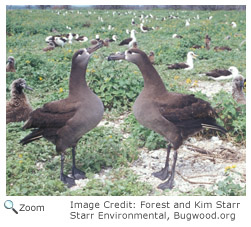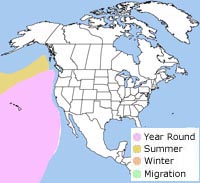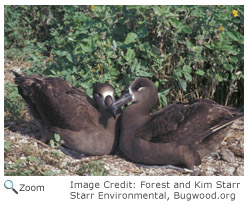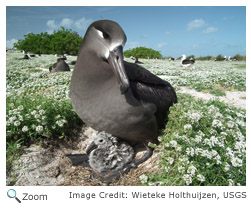Description  The black-footed albatross is between two and three feet in length with a wingspan of up to seven feet. It has brown to black feathers with white around its eyes and bill. It has a large brown bill with a curved tip and black feet. Males are larger than females. The black-footed albatross is between two and three feet in length with a wingspan of up to seven feet. It has brown to black feathers with white around its eyes and bill. It has a large brown bill with a curved tip and black feet. Males are larger than females.
Range  The black-footed albatross breeds on islands in the mid-Pacific Ocean. Non-breeding albatrosses can be found along the Pacific coast of North America. The black-footed albatross breeds on islands in the mid-Pacific Ocean. Non-breeding albatrosses can be found along the Pacific coast of North America.
Habitat
The black-footed albatross is found on open ocean waters and ocean islands.
Diet In the summer, the black-footed albatross often follows fishing boats to feed on the waste. Its diet is made up of mostly fish, fish eggs, and squid. It scoops up its food from the surface of the ocean and catches most of its food at night.
|
|
Life Cycle  Mating season runs from November through February. Females and males do a mating ritual that involves twining their necks together and flapping their wings. Mating season runs from November through February. Females and males do a mating ritual that involves twining their necks together and flapping their wings.
 Females lay one egg in a shallow depression in the ground. The black-footed albatross nests on islands in colonies. Both the male and the female incubate the egg and feed the chick regurgitated food. Once a chick leaves the nest, it won't return to the breeding island for five or six years, when it is fully mature. The black-footed albatross mates for life. Females lay one egg in a shallow depression in the ground. The black-footed albatross nests on islands in colonies. Both the male and the female incubate the egg and feed the chick regurgitated food. Once a chick leaves the nest, it won't return to the breeding island for five or six years, when it is fully mature. The black-footed albatross mates for life.
BehaviorThe black-footed albatross chases other predators away from its food by spreading its wings and screaming at them.
For more information about the albatross, visit the Albatross Project at Wake Forest University.
|



 The black-footed albatross breeds on islands in the mid-Pacific Ocean. Non-breeding albatrosses can be found along the Pacific coast of North America.
The black-footed albatross breeds on islands in the mid-Pacific Ocean. Non-breeding albatrosses can be found along the Pacific coast of North America.
